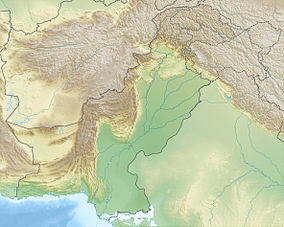Lal Suhanra National Park
| Lal Suhanra National Park لال سہانرا نیشنل پارک | |
|---|---|
| Location | Punjab, Pakistan |
| Nearest city | Bahawalpur, Pakistan |
| Coordinates | 29°19′N 71°55′E / 29.317°N 71.917°E |
| Area | 65,791 ha |
| Established | 1972 |

Lal Suhanra is a
There are archaeological remains of the ancient
Geography
Lal Suhanra National Park is situated some 35 kilometres east of Bahawalpur and presents a synthesis of forest and desert life.[2] It occupies land on both sides of Desert Branch canal, and is spread over 127,480 acres (51,590 hectares) of which 20,974 acres (8,488 hectares) are green land (irrigated plantations), 101,726 acres (41,167 hectares) are dry land (desert), and 4,780 acres (1,930 hectares) are wet land (ponds and lakes). The park's terrain is generally flat, interspersed with
The biosphere reserve is crossed by the dried-up bed of the Ghaggar-Hakra River and comprises Patisar Lake and irrigated land. Officials said that indigenous trees like
Wildlife
Many species live throughout the park, including
Lion safari
The Punjab government has plans to convert Lal Sohanra National Park into a wildlife safari park of international standard. One of its most prominent attractions is the lion safari, which allows guests to see lions in their natural habitat at close range.[5]
See also
References
- ^ "Lal Suhanra". UNESCO. Retrieved 28 December 2016.
- ^ a b c "Lal Suhanra National Park". Forest, Wildlife and Fisheries Department, Punjab. Retrieved 28 December 2016.
- ^ Abdul Manan (February 18, 2016). "PM Nawaz returns to old haunt to enjoy desert skies, music and milk". The Express Tribune. Retrieved 28 December 2016.
- ^ "Lal Suhanra National Park". Pakistan Tourism Portal. Retrieved 4 July 2022.
- ^ "Pakistan hopes Nepali rhinos will breed, multiply". SOS Rhino. Retrieved 28 December 2016.

